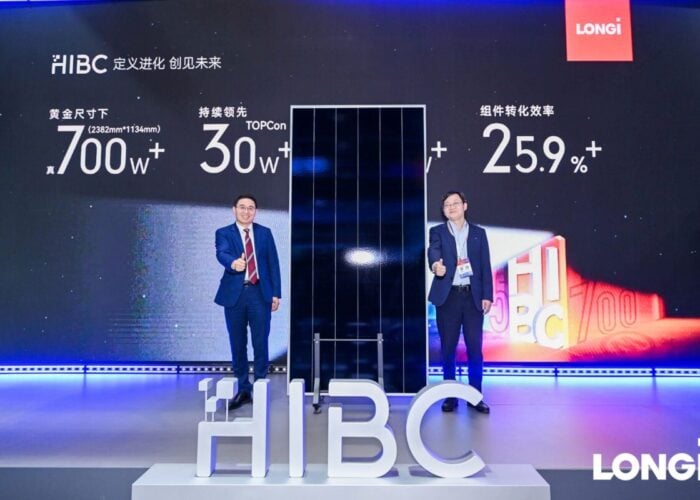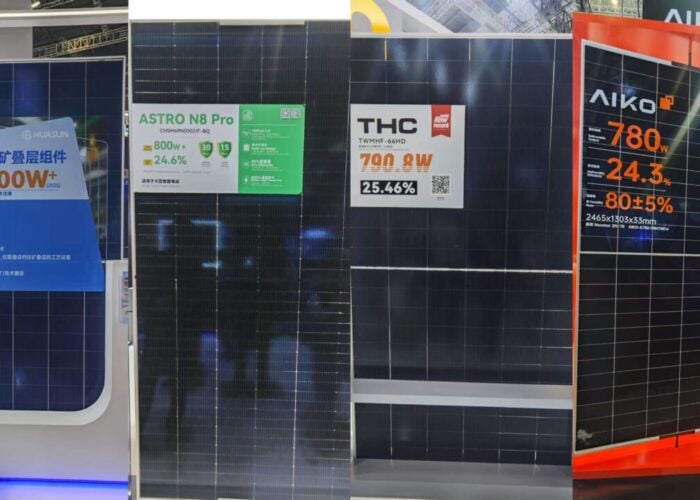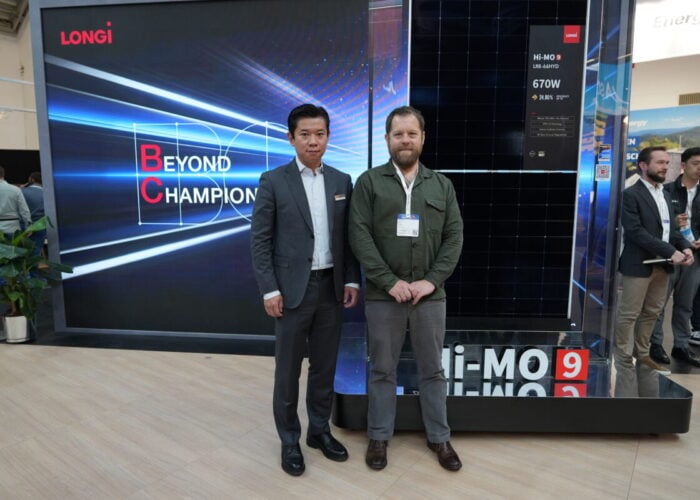
Less than a fortnight after Zhonghuan Semiconductor (TZS) dropped its wafer prices significantly, LONGi has followed suit, cutting its prices for the second time in a just over a month. Collapses in pricing across the solar value chain have now become sustained, establishing itself as a key trend as the year draws to a close.
On 16 December, LONGi published its latest price list for its range of wafers, confirming price reductions of at least 5% across its product line. The update confirmed a 5.7% reduction of its M10 182mm wafer price to RMB5.85 per piece, while M6 (166mm) wafers fell by 5.5% to RMB5.03/pc. Prices for the manufacturer’s 158.75mm wafers fell by 5.7% to RMB4.83/pc.
Unlock unlimited access for 12 whole months of distinctive global analysis
Photovoltaics International is now included.
- Regular insight and analysis of the industry’s biggest developments
- In-depth interviews with the industry’s leading figures
- Unlimited digital access to the PV Tech Power journal catalogue
- Unlimited digital access to the Photovoltaics International journal catalogue
- Access to more than 1,000 technical papers
- Discounts on Solar Media’s portfolio of events, in-person and virtual
| Date | Product | Price (RMB) | Price (USD) |
| 16/12/21 | M10 (182mm) wafer | 5.85 | 0.917 |
| 16/12/21 | M6 (166mm) wafer | 5.03 | 0.788 |
| 16/12/21 | G1 (158.75mm) wafer | 4.83 | 0.757 |
In a statement, LONGi said the price adjustment was triggered by conditions upstream, with wafer price reductions expected to ricochet further down the value chain.
According to industry analysis, TZS is now likely to follow suit, continuing a downward trend for wafer prices that started in November. Other suppliers have also lowered their prices, with wafer suppliers facing considerable inventory pressure this month on the back of dampened demand. Approaching the end of the year, wafer companies are clearing out old inventories through price reductions in the hope of boosting end of year performance metrics
Outside of wafers, prices for other products in the industrial chain are also decreasing. Data from the Silicon Industry of China Nonferrous Metals Industry Association showed that the trading price for mono silicon stands at around RMB251/kg (inclusive of China’s VAT), a quarterly decrease of 4.2%. Silicon material price have dropped by over 7% in total this month.
An industry source told PV Tech Premium that the general expectation is that prices for polysilicon in excess of RMB250/kg will quickly become a thing of the past.
Cell prices are also trending downward. The latest EnergyTrend price monitoring results showed that prices for 158.75mm cells have fallen to RMB1.08/W and 166mm cell prices decreased to RMB1.02/W. Prices for 182mm cells dropped to RMB1.08/W, while 210mm cell prices fell to 1.05 yuan/W.
The prices for glass, EVA, aluminum frame and silver paste also decreased. Data from Solarbe showed that EVA prices plunged by 8.49% compared with earlier this month, while the cost aluminum frames reduced by 0.82% compared with last week and glass prices fell marginally too. The cost of 3.2mm glass was RMB25.5/㎡ on average last week, down by 1.92%.
As upstream product prices slid one after another, wait-and-see sentiment is growing within the ranks of end users who may now wait for next year’s module prices, expecting them to fall further.
The module price is indeed loosening, especially for the large-scale mono crystalline modules. While some leading module makers have maintained prices, most tier two and tier three manufacturers have adjusted their prices. Some have even sold at ‘fire sale’ prices due to mounting inventory pressure.
EnergyTrend has monitored the price of some 500W or higher grade single-glass modules, noting prices to stand as low as RMB1.85-1.88/W (US$0.29 – 0.294c/W) . Furthermore, the market is undergoing an unsettled period with few transactions to have closed of late. Currently 166mm module prices are quoted at RMB1.88/W, 182mm module at RMB1.90/W and 210mm modules at RMB1.91/W.
| Module (per Watt) | High price point | Low price point | Average price | Fluctuation |
| 275-280/330-335W poly module (RMB) | 1.780 | 1.650 | 1.680 | -1.18% |
| 275-280/330-335W poly module (USD) | 0.280 | 0.230 | 0.234 | -1.27% |
| 355-365/430-440W mono PERC module (RMB) | 2.050 | 1.830 | 1.880 | -3.59% |
| 355-365/430-440W mono PERC module (USD) | 0.355 | 0.255 | 0.262 | -9.66% |
| 182mm mono-facial mono PERC module (RMB) | 2.070 | 1.880 | 1.900 | -3.06% |
| 210mm mono-facial mono PERC module (RMB) | 2.080 | 1.920 | 1.910 | -3.54% |
Into 2022, demands for modules will originate mainly from the Indian market and ongoing domestic projects. However, before the industrial chain price stabilises, the module market will still mainly accommodate smaller orders and orders from previous periods.
In terms of the expectation for 2022 module prices, the industry is calling for prices to return to RMB1.8/W and lower. A conservative speculation will be RMB1.75 – 1.8/W, while more radical forecasts call in the range of RMB1.66 – 1.6/W.







